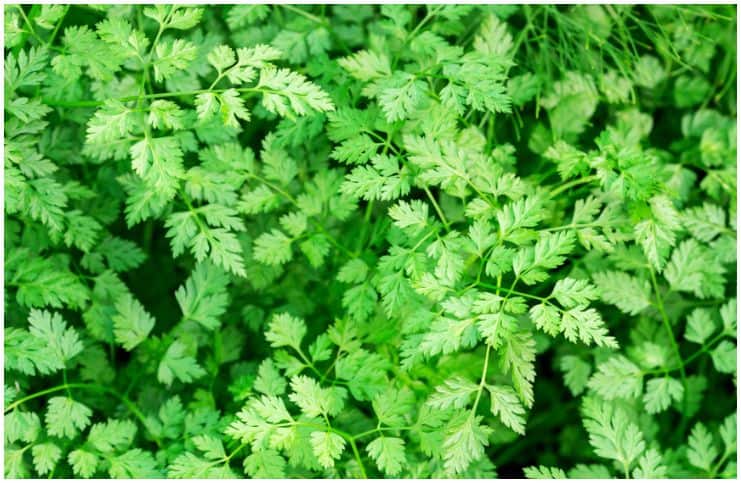Chervil (Anthriscus Cerefolium) – Side Effects, Facts, Uses, Health Benefits:
Facts
Sometimes called garden chervil or French parsley, it is a member of the Apiaceae family, related to carrots, dill, parsley, and fennel.
It is an annual herb and is best known for being a „sweet” herb. Frequently referred to as the „gourmet’s parsley” due to its flavor, this plant tastes like a mix of anise and parsley.
It is native to southern Russia and western Asia, and it has been known and cultivated in France for centuries. It was introduced into most of Europe by the Romans, who claimed that it increased memory power.
A Greek folk custom was to carry a sprig of chervil to wave blessings to friends. During the Middle Ages, chervil was used to protect against the plague and is a traditional symbol of new life.
The 17th-century herbalist Nicholas Culpeper made a claim citing that the herb „does much to please and warm the old and cold stomach.”
The herb can grow to reach a height between 40 and 70 cm. It has tripinnate leaves and white, small flowers and has a small fruit, about 1 cm long.
Fresh stems and leaves are used, especially in France, to season seafood, poultry, soups, salads, young spring vegetables (such as carrots), and sauces.
Chemical Composition
This plant is a great source of minerals like potassium, iron, magnesium, zinc, copper, manganese, phosphorus, selenium, and calcium. It is also a rich source of vitamins A, B, C, and D.
It is low in essential oil content, which is 0.3%, but this may be extracted from its seeds. Some of the prime chemical substances of the herb are – hendecane (or undecane) and methyl chavicol (or estragole).
It is also a rich source of bioflavonoids, which aid the body in many ways, including vitamin C absorption.
Uses and Health Benefits of Anthriscus Cerefolium
The health benefits of this herb were described by the Roman scholar Pliny, and during the Middle Ages, it was used to treat different ailments.
It is claimed to assist with conjunctivitis, thrombosis, digestion, and high blood pressure, and delay the onset of wrinkles.
It’s also considered to increase memory, and many students drink this tea before exams. In addition, the herb reduces the effect of allergic reactions, helps in the treatment of allergies, and gently promotes the body’s natural waste removal system.
One of the usual problems that most women face is extra water retention. This herb, due to its mild diuretic properties, can eliminate excess fluids from the body. Additionally, it can also help combat abdominal pain and menstrual cramps.
The herb also prevents and cures gum diseases and mouth ulcers. It is also beneficial for people who suffer from bladder disorders, kidney disorders, and cystitis.
A tea from this herb is known in folk remedies and is used seasonally as a blood purifier and a soothing eyewash. Applying the tea as part of a face mask can reduce the appearance of wrinkles and improve the elasticity of the skin.
Many nutritionists recommend this tea to alleviate nervous tension, anxiety, and other effects of stress.
It can lower your LDL cholesterol quite easily if you make it a point to consume it frequently. High levels of low-density lipoprotein cholesterol are an important risk factor for coronary heart disease.
The risk is especially high if you have a high level of LDL cholesterol and a low level of HDL cholesterol.
Moreover, it can be used in the regular diet to lower high blood pressure.
Having high blood pressure puts you at risk for stroke and heart disease, which are leading causes of death in the US. For example, approximately 1 of every 3 adults in the United States have high blood pressure – that’s 75 million people.
Side Effects of Chervil
In food amounts, this herb does not cause any side effects. Avoid it during pregnancy as it may cause mutation in the genes of the fetus.
Consult a healthcare specialist before trying any herbal supplement, especially when taking medications or diagnosed with chronic illnesses.
READ THIS NEXT:
Mirabilis Jalapa Medicinal Uses & Health Benefits
Arnica Montana – Health Benefits
Tripterygium Wilfordii – Side Effect
References https://www.sciencedirect.com/topics/agricultural-and-biological-sciences/chervil https://www.researchgate.net/publication/275982022_Chervil_A_Multifunctional
